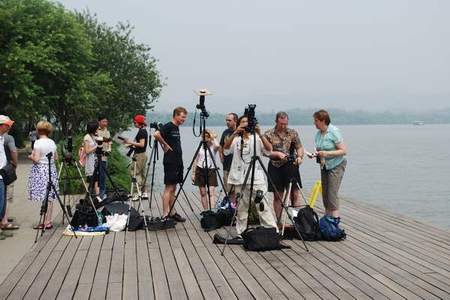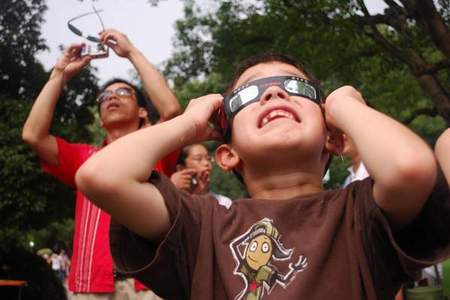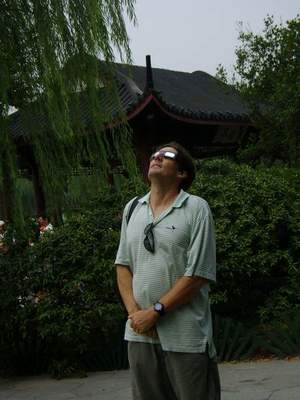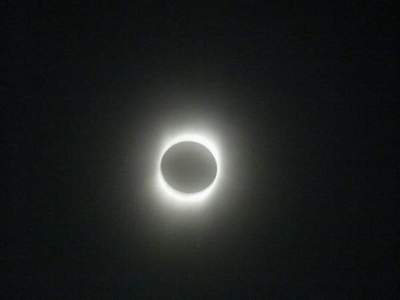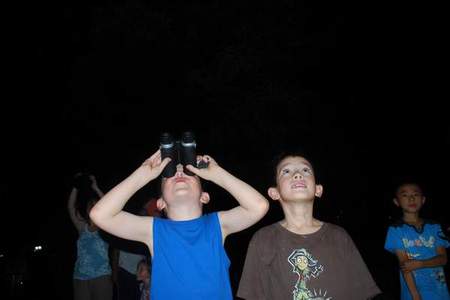Total Eclipse 2009
Eclipse Basics
I've literally been planning to go to China for the July 22, 2009 eclipse for ten years. During those ten years, I often mentioned my plan to others, who responded by saying, I've seen lots of total eclipses right at home. Why do you need to travel so far? The fact is, they probably haven't seen total eclipses from their home. Their faux pas seems to be the result of a misunderstanding of eclipse terminology. The last total eclipse visible in the continental United States was on February 26, 1979 , and it could only be seen in the northwestern states. Most Americans claiming to be total eclipse veterans were either not born at that time or were not in the right location on that date. So, let me clear up some solar eclipse terms before telling my story. If you already know a partial from a total eclipse, you can skip this part.
Partial Eclipse: When the moon partially blocks the sun, it is known as a partial eclipse. Such a phenomenon results when the earth, moon, and sun are in close, but not exact, alignment. Safety precautions are required to view partial eclipses, such as protective glasses or a flat surface with a hole poked out. The next partial eclipse will be on January 4, 2011 , and will be visible mostly over parts of Africa, Europe and Asia. 35.3% of eclipses are partial.
Total Eclipse: When the moon completely blocks the sun, you have a total eclipse. For a total eclipse to occur, the earth, moon, and sun must be in exact alignment, and the moon must be close to the earth in its elliptical orbit. During the few minutes when the moon completely covers the sun, the sky will turn dark, and the eclipse can be viewed safety with the naked eye. Viewing a total eclipse is rare due to their infrequency and often very inconvenient locations, like over the ocean. For example, in the continental United States, there were/will be zero total eclipses from 1980 to 2016. To make things even harder, the sun is completely eclipsed by the moon on only a thin path about 100 miles wide, while the sun will appear partially eclipsed over an area about 4000 miles wide. The next total eclipse will be on July 11, 2010 , mostly over parts of the southern Pacific Ocean. 26.7% of eclipses are total.
Annular Eclipse: When the sun forms a thin ring around the moon, it is known as an annular eclipse. For an annular eclipse to occur, the earth, moon, and sun must be in exact alignment, and the moon must be far from the earth in its elliptical orbit. The same kind of safety precautions needed for partial eclipses are required for annual eclipses. The reason that some eclipses are annular and some are total is the moon does not travel in a circular orbit around the earth, but rather in a lopsided, elliptical orbit. It is coincidental that the moon takes up about the same amount of area in the sky as the sun. When the moon is far from the earth, it appears smaller and results in an annular eclipse when the sun, earth, and moon are in alignment. When the moon is close to the earth, it appears larger than the sun and results in a total eclipse under the right alignment conditions. The next annular eclipse will be on January 15, 2010 , mostly across parts of the Indian Ocean. 33.2% of eclipses are annular.
Hybrid Eclipse: When an eclipse is seen as annular in some places and total in others, it is known as a hybrid eclipse. These eclipses result when the moon's orbiting position makes it appear larger than the sun in some spots on the earth and smaller in others. These eclipses are very rare and short in duration when they do appear as total eclipses. The next hybrid eclipse will be across parts of Africa on November 3, 2013 . 4.8% of eclipses are hybrids.
In conclusion, if you couldn't look straight at the eclipse with your naked eye, you didn't see a total eclipse.
The Mexican Eclipse of 1991
I'm not exactly sure when my quest to see an eclipse started. My father saw a total eclipse in 1979 in Washington State, returned home happy, and put a picture from it in dining room, which I spent many years looking at. At UCSB my astronomy teacher was also an eclipse buff, and shared with us lots of pictures and details about total eclipses he had seen.
At some point after I graduated I think I went to the library and learned there was to be a total eclipse passing through Mexico on July 11, 1991 . The path of totality went right over Cabo San Lucas and parts of Hawaii. Although I strongly wanted to go, events in my life at the time worked against me. I had recently started a new job, I had little vacation time, and I had little savings. While I could have made it happen, had I borrowed money and called in sick, the pragmatist in me won, as it usually does, and I sulked into the office that day. They had wonderful weather in Cabo too, where I would have gone.
The European Eclipse of 1999
So on the date of the Cabo eclipse, I vowed to see the next practical total eclipse, which was on August 11, 1999 . The path of totality passed over many European countries, including Germany, where I wanted to go anyway. Before I got married in 1994, I specifically told my wife I intended to be in Germany on that date. Five years notice should have been enough. However, our first child was born in August 1997. On the day of the eclipse, she would have been six days short of her second birthday. At the time, we could barely afford me making the trip, not to mention all three of us. While nobody was chaining me to the house, I basically didn't have enough husbanding points saved up to make the trip and still be welcomed back. So the pragmatist in me won again, and I sat at home and sulked on the big day. I did make it to Germany the following year, which was of some consolation. On a tour of a brewery I noticed a bottle of eclipse beer.
The Chinese Eclipse of 2009
The only thing that was accomplished the day of the European eclipse is I postponed my quest until July 22, 2009, when a long total eclipse would be viewable over major cities in China, including Shanghai. Over the 2000-2009 decade (somebody needs to come up with a term for this decade, and the next one), I spoke of it often. This lead to the many incorrect claims of having seen total eclipses from people who couldn't have, and who obviously didn't understand the difference between a partial and a total eclipse, as I already ranted about. Fortunately, events in my life were lining up nicely. I was financially endowed enough to make the trip with the whole family. As the big day drew near, I had ten other people in my entourage: my wife, my three kids, my wife's parents, two married friends, and the friends' two children. It only took 18 years of planning.
The July 22, 2009 eclipse was a special one. At a maximum duration of six minutes and 39 seconds, it would be the longest eclipse until the year 2132 . The path of totality went over several major cities in India and China. If good weather prevailed, and superstition didn't, it was said that it would be the most viewed eclipse in human history. I mention superstition because many people in India stayed indoors, under the obviously incorrect notion that eclipses cause miscarriages in pregnant woman. I file such people in the same folder as those who believe that betting systems can beat games like roulette and craps.
For years, I envisioned myself watching the eclipse with 17 million other people in Shanghai. However, as the date drew near, eclipse web sites recommended the nearby city of Hangzhou because of better odds of good weather. On the morning of July 20, we landed at Pudong airport in Shanghai and immediately went by van to Hangzhou, which is about a two to three hour drive from Shanghai depending on traffic and whether your driver gets lost (which ours did).
I had been to Hangzhou before, 19 years ago. The city has a lovely lake, known as West Lake, surrounded by beautiful Chinese landscaping. However, encircling that tourist-based part of the city are miles of drab concrete buildings and terrible traffic. If you go to Hangzhou, be sure you stay by the lake, or don't bother going at all. You'll pay a lot extra for the convenience, but it is worth it. I would also wait for the high-speed rail line to Shanghai to be completed in 2010.
In the middle of July, Hangzhou was, simply put, hot as hell, and this is coming from somebody who lives in Las Vegas. While we were there, the humidity was near 100%. Not only did that make going outdoors uncomfortable, but it also did not bode well for clear skies on the big day. I spent a lot of time watching the news, broadcast in Chinese, and I could see from the maps and charts that Shanghai was forecast to be a complete rain out. Nobody mentioned Hangzhou on the news, but the two cities are not far apart, so I expected the worst.
The Big Day
Early the morning of the 22nd, it rained in Hangzhou, pretty hard. At about five in the morning, I wandered into the hotel lobby with nothing better to do, and the place was full of young men in eclipse t-shirts carrying fancy telescopes and cameras. Despite the weather, they looked happy, and rip roaring and ready to go. I witnessed them piling into vans for I have no idea where. Perhaps they were headed for higher ground, or to view the associated tidal bore near the city.
In Hangzhou, the moon started to cover the sun at about 9:00 AM, with the period of totality commencing at about 9:40 AM. By 8:30, the rain had stopped and we headed out for a good viewing spot. We needed to only cross the street to have a nice spot at a gazebo by the lake. As the minutes passed, more and more people gathered. In certain spots, the serious eclipse chasers gathered with all their gear to watch the event properly. However, the vast majority, including us, had only cheap paper glasses. Our group of eleven had to share two pairs, because we bought the last of them the hotel had. My father, who has seen lots of total eclipses, recommended that for the first one that you just enjoy it and not worry about telescopes or taking lots of pictures.
At about 9:00 AM, when the eclipse started, the cloud cover was still heavy. You could safely look anywhere in the sky to find the sun, because it was nowhere to be seen. However, fortunately, as the minutes ticked by, the sun started to peek out from time to time between the clouds. As if by divine intervention, by 9:20 the clouds has mostly cleared, and you could acutely see the status of the eclipse through the protective eyeglasses. The sky started to get darker, and the crowd became excited.
Words cannot explain the anticipation I felt during the last few seconds of sunlight. Gradually the sun's crescent became thinner and thinner, and the sky grew darker and darker. When there was just a pinprick of sunlight left, I disregarded the advice I have heard for years and peeled off my glasses. I watched for a few seconds with my naked eye. At this time, those with telescopes and protective lenses can see the sun as it moves around between the mountains of the moon. To me, it looked like an extremely bright point in the sky, like a star.
Then the sun was gone. The sky suddenly turned all the way dark, prompting streetlights to come on. A silence fell over the crowd. As any eclipse picture will show, a kind of halo appeared around the moon. I could clearly see a planet, and I probably could've see some stars were it not for the humid haze and ubiquitous Chinese air pollution. When stars are visible during an eclipse, they are those you would normally have to wait six months to see, when the earth is on the other side of its orbit around the sun. At this point, words and pictures fail to capture the moment. You simply have to experience it yourself to know what it is truly like. And perhaps for me, the moment was even greater due to the decades of planning and anticipation I'd gone through.
During the first minute or so of total darkness, the crowd was very respectful and quiet. Most people simply stared, lost in their own thoughts. However, this was a long eclipse, and there was time to do more than that. Gradually people, including our group, started taking pictures, murmuring, and making observations about the city around us. It was a special time, being in total darkness at 9:40 in the morning. I imagine that for most in the crowd, it would be the only time in their lives they would witness a total eclipse.
Towards the end of the period of totality, you could tell the halo was getting brighter on the top than on the bottom. The sky started to become a little lighter. Then, suddenly, a pinprick of bright sunlight appeared, marking the end of the totality period, like a bookend to the pinprick of light that started it. At that moment, the sky instantly became bright, and the crowd erupted in chatter. It was a moment to be cherished, a moment of pride. Although we were strangers, we all simultaneously became eclipse veterans.
Back in the hotel room, the local Hangzhou news spoke about the eclipse non-stop, for hours. The newscasters were completely giddy. By the way, Shanghai was completely rained out. They experienced the darkness but none of the spectacular effects that require clear skies. Two days later, we traveled to Shanghai, and everyone I spoke to said they were very disappointed.
Future U.S. Eclipses
Not only have I been planning for this eclipse for years, but I'm also planning for upcoming total eclipses in the United States on August 21, 2017 and April 8, 2024 . I'll be 52 and 58 in age respectively. There will be a third on August 12, 2045 , going right over northern Nevada. I'll be 80 by then, but the odds are good that I'll make it. The one in 2017 will not be long, with a maximum time of 2 minutes and 40 seconds, but it will be visible from Oregon to South Carolina. I'm tentatively planning to watch it near Idaho Falls, but I'm flexible at this point. For anybody who can make the trip to see it, I highly recommend it. If you see me, please say that my blog of 2009 inspired you.
Links
In closing, here are some links for more information.- Nasa.gov: This page links to details about every total eclipse from the years 1850 to 2100.
- Wikipedia: Entry about the total eclipse of July 22, 2009.
- China Daily: Eclipse Shines on Tourism
- MSNBC: Asians Witness 21st Century's Longest Eclipse
- Hermit.org: Total solar eclipse of August 21, 2017





